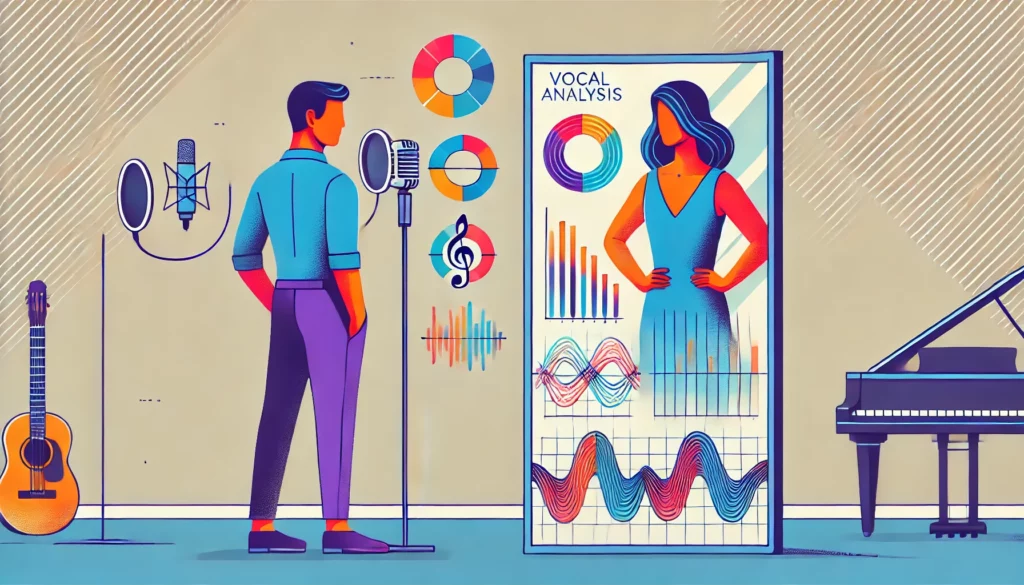
In music, as in life, self-awareness is the invisible conductor orchestrating growth. Pianists scrutinize finger velocity; violinists measure bowing precision; yet singers, curiously, often trust feelings alone—a fleeting compass at best. Ironically, the human voice, our most intimate instrument, remains shrouded in mystique, evaluated chiefly by subjective ears rather than objective measures. What if instead, vocalists harnessed systematic voice training with clear benchmarks and insightful analyses, transforming singing from a vague pursuit into a measurable journey of progress?
Indeed, subjective ears can deceive—even the finest opera divas might flatter themselves into believing they’re flawlessly on pitch, or conversely, torment themselves with imagined flaws. This is precisely why vocal analysis should be treated not merely as an occasional indulgence but as a habitual rite of passage—much like stepping onto a scale at the gym. Systematic assessment of one’s singing—tracking pitch accuracy, breath management, diction, and other vocal intricacies—illuminates precisely what feelings alone obscure. Just as a fitness enthusiast carefully monitors their heart rate, strength, or speed, so too can vocalists measure their progress through methodical analysis, making voice training not merely art, but also a disciplined craft.
Thankfully, the age we inhabit offers vocalists more than subjective speculation—it gifts them with technology that transforms intuition into tangible clarity. Platforms such as Singing Carrots have emerged, crafting sophisticated yet intuitive tools to illuminate the subtle nuances of your voice. By embedding vocal analysis into your regular voice training, you grant yourself an objective mirror: real-time feedback on pitch precision, clear visualizations of vocal range, and measurable progress in mastering breath control and vocal technique. Singing Carrots, in particular, has elegantly systematized this approach into a comprehensive voice training framework, offering practical tools that make self-assessment as accessible and engaging as your daily smartphone ritual.
How Vocal Analysis Can Transform Your Voice Training Routine
1. Intonation: The Art of Hitting the Bullseye
At its core, singing is about precision; each note an invisible target suspended in acoustic space, waiting patiently for the singer’s arrow to strike true. This pursuit of pitch accuracy—intonation, in professional parlance—is often misunderstood as something innate, a mysterious talent one either possesses or lacks. In reality, intonation is a subtle dance of intervals between flat and sharp, constantly refined through deliberate practice. Regularly analyzing your intonation as part of your voice training routine transforms this elusive aspect of singing into a skill you can objectively measure and methodically improve, note by note hitting the appropriate pitches.
2. Breath Management: Mastering the Invisible Fuel
Breath is to singing what oxygen is to fire: invisible yet indispensable. And though breathing seems intuitive—after all, haven’t we all been doing it rather well since birth?—in singing, it demands conscious discipline. Proper breath management transforms mundane inhales and exhales into a finely tuned mechanism, adapting effortlessly to the song’s emotional demands. Short phrases call for nuanced breaths; excessive intake merely blocks fluidity, while lengthy passages demand precise calculation, strategic reserves carefully measured to sustain tone without strain. By regularly analyzing your breathing technique during voice training, you learn to calibrate your breaths like a skilled diver preparing for a long underwater voyage—taking neither too little nor too much, always mindful of the journey ahead.

3. Vocal Registers: Navigating the Landscape of Your Voice
The human voice is a fascinating instrument—fluid and adaptable, yet bound by its own subtle architecture. Vocal registers—those distinctive tonal “zones” such as chest voice, falsetto, mix, or whistle register—form the very landscape of our singing. Each register carries its own character, vibratory patterns, and emotional color. Mastering the transitions between these registers, much like skillfully shifting gears in a finely tuned sports car, requires awareness and deliberate practice. Incorporating vocal register analysis into your routine voice training helps you map this sonic terrain clearly, identifying smooth pathways and recognizing precisely where tension or cracks may lurk. Through this conscious exploration, vocalists find themselves navigating their vocal landscape not by chance, but with intention and mastery.
4. Constriction: Freeing the Hidden Tension
Every singer, at some point, encounters the unwelcome sensation of constriction—a tightening, almost choking feeling that can sabotage the most confident performances. This tension isn’t mere coincidence; rather, it’s a primal, protective reflex within our bodies, attempting to shield us from perceived danger. Ironically, in singing, the greatest danger is often fear itself—fear of high notes, fear of failure, fear of exposure. Constriction usually arises from subtle tensions in the jaw, tongue, or abdomen, silently restricting vocal freedom. By methodically analyzing these subtle physical reactions during regular voice training, singers learn to recognize constriction not as an enemy to battle, but as a signal gently urging relaxation, openness, and trust. Vocal freedom, paradoxically, comes not from force, but from letting go.
5. Nasality and Twang: Embracing Your Vocal Colors
In the art of singing, tone color is the vibrant palette through which singers convey meaning and emotion. Two intriguing shades within this palette are nasality and twang—often misunderstood or misused, yet capable of lending striking character to a voice when skillfully controlled. Nasality occurs naturally when sound partially resonates through the nasal cavity, lending a unique, often piercing timbre. Twang, similarly distinctive, brightens a voice by subtly narrowing the space in your throat, projecting a clearer, louder resonance without added effort. However, just as spices enhance but can overpower a dish, uncontrolled nasality and excessive twang risk distorting vocal clarity. Regularly analyzing these vocal nuances as part of structured voice training allows singers to embrace nasality and twang deliberately, adding artistic depth without overwhelming the ear.

6. Articulation and Diction: Clarifying Your Message
Words matter—yet how often do we find ourselves captivated by melodies but unsure about what exactly was sung? Clear diction is the unsung hero of great singing. Proper articulation transforms vocal expression into meaningful communication, ensuring your audience doesn’t just hear, but truly listens. Imagine diction as a delicate sculpture: each consonant precisely carved, each vowel thoughtfully shaped, creating clarity from musical chaos. By incorporating self-recording and diligent listening into your regular voice training, you foster an awareness of diction, turning vague mumbling into articulate storytelling. Clear singing isn’t merely beautiful; it’s compelling, powerful, and undeniably memorable.
7. Posture: Aligning the Instrument Within
Your body is the grand architecture within which your voice resides. Like the careful positioning of a violinist’s bow arm or a pianist’s wrist, posture deeply influences vocal production. A collapsed posture restricts breathing, limits vocal resonance, and hinders expressivity, whereas aligned posture liberates the voice, enabling effortless projection and full tonal resonance. As part of consistent voice training, regularly assessing and adjusting your posture becomes a fundamental ritual—aligning your spine, relaxing your shoulders, and grounding your stance. This attention transforms the singer’s entire body into a harmonious instrument, resonating with every note sung.
Integrating Vocal Analysis into Your Practice Routine
As we’ve explored, systematic vocal analysis isn’t an occasional luxury but rather a foundational practice, essential for genuine growth in singing. Just as instrumentalists measure tempo, rhythm, and pitch, singers too benefit immensely from a structured approach, measuring aspects from intonation and breath management to diction and physical alignment. The goal of vocal analysis isn’t to obsessively critique, but rather to illuminate the path forward, empowering singers to transform vague instincts into clear, actionable improvements.
To integrate vocal analysis effectively, simply set aside dedicated time each week—recording yourself, listening closely, and thoughtfully reflecting on each technical element we’ve discussed. By tracking your progress consistently, you build tangible momentum, motivated by visible, measurable improvements rather than fleeting impressions or subjective opinions.
Taking the Next Step
Incorporating structured vocal analysis into your regular voice training ultimately changes your relationship with singing. It transforms a mysterious talent into a measurable, developable skill—shaping not just your voice, but your confidence and artistry. For those eager to embrace this structured approach fully, platforms like Singing Carrots offer a carefully designed pathway, balancing insightful analysis with engaging, step-by-step exercises.
In the end, the beauty of singing is not diminished by structure or analysis; rather, it’s enriched. Clear feedback, consistent measurement, and systematic practice illuminate your unique vocal journey, turning your voice into a powerful instrument of authentic expression.










![Wong Diane – Now Only Me (Single Review) Wong Diane Now Only Me [Single Review]](https://musicreviewworld.com/wp-content/uploads/2023/08/Wong-Diane-Now-Only-Me-Single-Review-1-356x220.png)



